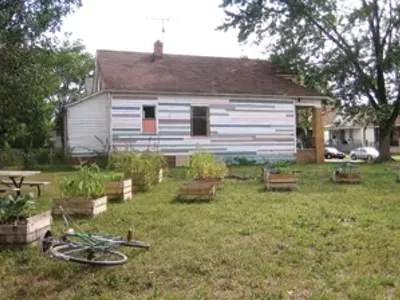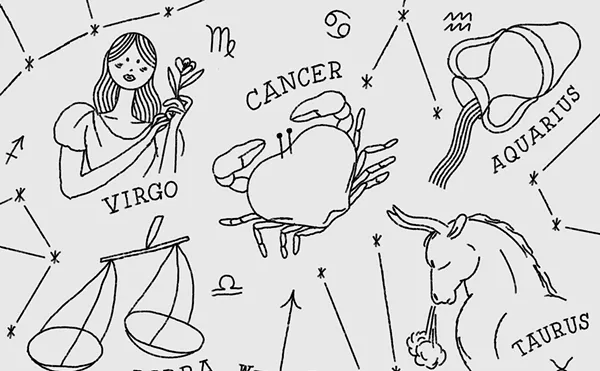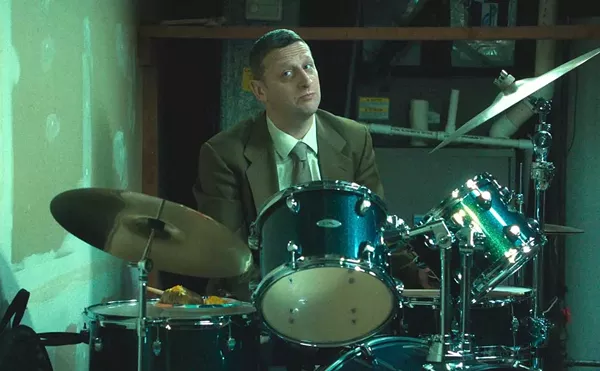
Audio By Carbonatix
[
{
"name": "GPT - Leaderboard - Inline - Content",
"component": "35519556",
"insertPoint": "5th",
"startingPoint": "3",
"requiredCountToDisplay": "3",
"maxInsertions": 100,
"adList": [
{
"adPreset": "LeaderboardInline"
}
]
}
]
Editor's Note: In September 2004, two Berliners, Stéphane Orsolini and Erika Mayr, visited Detroit after participating in the German-funded international Shrinking Cities competition. They greeted the city with a proposal for urban beekeeping as one possible solution to postindustrial challenges.
Four years later, Mayr, a horticulturist and beekeeper, and Orsolini, a London-trained architect with his own practice, are in the final phase of designing BEES, their plan to build and install legal temporary apiaries and bee pastures on vacant city-owned lots in Detroit. Here's why, and how:
Honeybees forage among flowers for nectar and pollen, which they carry to their hives as food sources. In the process of foraging, bees gather pollen from one flower and deposit it on another, promoting cross-pollination and increasing the production of fruit and seed. On Oct. 5, 1999, the state of Michigan — an important fruit- and vegetable-producing state — designated the honeybee, Apis mellifera, as its official agricultural insect. The paradox is that from 1999 onward the number of bee colonies has been in constant decline. The situation is similar across the United States, with colony collapse disorder (CCD), a phenomenon in which honeybee colonies inexplicably lose their workers. On the market, that results in a higher demand for pollination service and an increase in pollination fees.
Meanwhile, changes in agricultural land-use policies and extensive use of pesticides and herbicides severely fragment bees' habitat and cause the death of millions of the greatest pollinators. As a result, the endangered bees have had to find new territories and have started developing a preference for cities, which, ironically, now offer greater biodiversity than their rural counterparts. Detroit is one of these cities.
Probably more than any major city in the country, Detroit abounds in nature. Urban farming has been practiced here since the beginning of the 1980s, when a dozen farms were set up within the city limits. There are now approximately more than 500, according to research conducted for Detroit's Department of Planning and Development.
Four years ago, we met with the "Big Three" — John Gruchala (Detroit Agriculture Network), Brother Rick Samyn (Capuchin Soup Kitchen, Earth Works Garden) and Paul Weertz (Catherine Ferguson Academy). These men, with the help of many gardeners, activists and workers from schools, churches, community organizations and food banks, initiated more than 40 community gardens and micro-farms. They started not only to grow food, but also to process and distribute it so they could support entire neighborhoods.
Detroit is not exactly what most people would consider a part of rural America; however, on our last visit, we bicycled around Detroit and spotted empty lots scattered all over the city (that same report for the city details more than 40,000 empty lots). And blight keeps creeping, especially in the eastern part of the city, where large parcels of vacant and underutilized land with a low potential of investment are found along industrial zones. In terms of land-use, boundaries are not clearly defined between industrial and residential zones. The city is looking for ways to put buffers between industrial and residential areas.
With permits from the city, we propose temporary apiaries and bee pastures. Urban prairies on city-owned vacant lots will be turned into nectar corridors. One-mile bands along industrial areas will be developed into valuable bee pastures around the apiaries. Collections of annual bee plants will link already established food sources with newly seeded land. This will be recognized as a mosaic of colorful patches and fields. The density of patches and fields depends on the amount of vacant land available. Fields will not be smaller than six lots whereas patches along trees and hedges can be much smaller in size.
The cultivation of bee pasture has a positive environmental impact and will improve the quality of life in these areas. Colorful fields will improve soil quality, reduce waste and revaluate the land. By improving the landscape for bees, we also improve the landscape for community residents, because pollination of existing vegetable gardens and orchards brings higher crop yields and encourages people to grow their own food. This could be the beginning of a local beekeeping industry that would first redevelop underutilized areas and then offer pollination service for fruit and vegetable farms in Michigan.
The pollination of Detroit will start with 30 oversized beehives; later, 300 to perhaps 3,000 hives will be strategically positioned.
Many people, of course, are fearful of bee stings. For this reason, we want to make sure the bees fly above peoples' heads. As they travel in a straight path to their hives, we plan to keep the beehives stored "up there" and out of the way — about 12 feet above the ground. The beehives will be colorful metal shells (yellow, red, blue) on different high structures. In each structure will be as many as five colonies. The houses will create an environment for the honeybee to survive winter in Michigan.
There will be several categories of beekeeping, including small-scale, nonprofit customary beekeeping, which already exists in Detroit, and large-scale, commercial beekeeping that could serve as a main source of income.
In general, bees fly only as far as necessary to secure an acceptable food source from which there is a net gain. We plan to install nectar corridors within a three-mile radius of hives, so bees will choose those fields first. Seed blends of annuals are a first step in the "food landscape improvement program" to revitalize buffer zones. Planted around the apiaries as nectar corridors, they offer attractive nectar-rich bee plants with a long flowering period. In the first years, we will use "Tübingen mixture," a blend of annuals developed for land in Europe. In the future we would like to develop local seed mixtures with high rates of seeding on the vacant sites. Native plants are undoubtedly a very good source of food for bees.
The project, called "BEES," will be a cooperative financed by members. Temporary use permits between BEES and the city will allow beekeepers to transform city-owned land into pastures or to simply use the land for the apiary. The project is at the final design phase. We await Detroit's new Master Plan of Policies. It is has already been mentioned that urban agriculture will be allowed on certain vacant lots. We would like to establish temporary use permits with the city to officially and legally use the land for urban beekeeping. As soon as we receive permission to use the land, we need sponsors for the first beehives and beehouses, as well as for the starting kit for beekeepers. The cost of setting up beehives is about $750 per beekeeper, including tools and equipment for two colonies.
For everyday operation, we will provide guidelines for such matters as correct hive placement, flight paths and barriers. This will create a sophisticated industry dedicated to not only producing honey or other hive products (known as customary beekeeping) but also allowing for pollination services (commercial beekeeping) to fruit and vegetable growers in the region.
The great diversity of vegetables and berries already found in Detroit's community gardens, the alfalfa and clover fields of the urban farms, the wildflower meadows on a good number of vacant lots, even the newly planted sunflowers on the grounds of Ford Headquarters in Dearborn, add up to a valuable source of nectar and pollen. In the future, this could be enhanced if beekeepers, gardeners and organizations such as the Detroit Agriculture Network, Earth Works Garden and the Greening of Detroit were to encourage more people to plant. Flower patches will decontaminate the soil, improve its fertility and, finally, contribute to a better environment. Someday, when driving through the city, look forward to seeing these structures as an integral part of Detroit's streetscapes.
Send letters to letters@metrotimes.com



